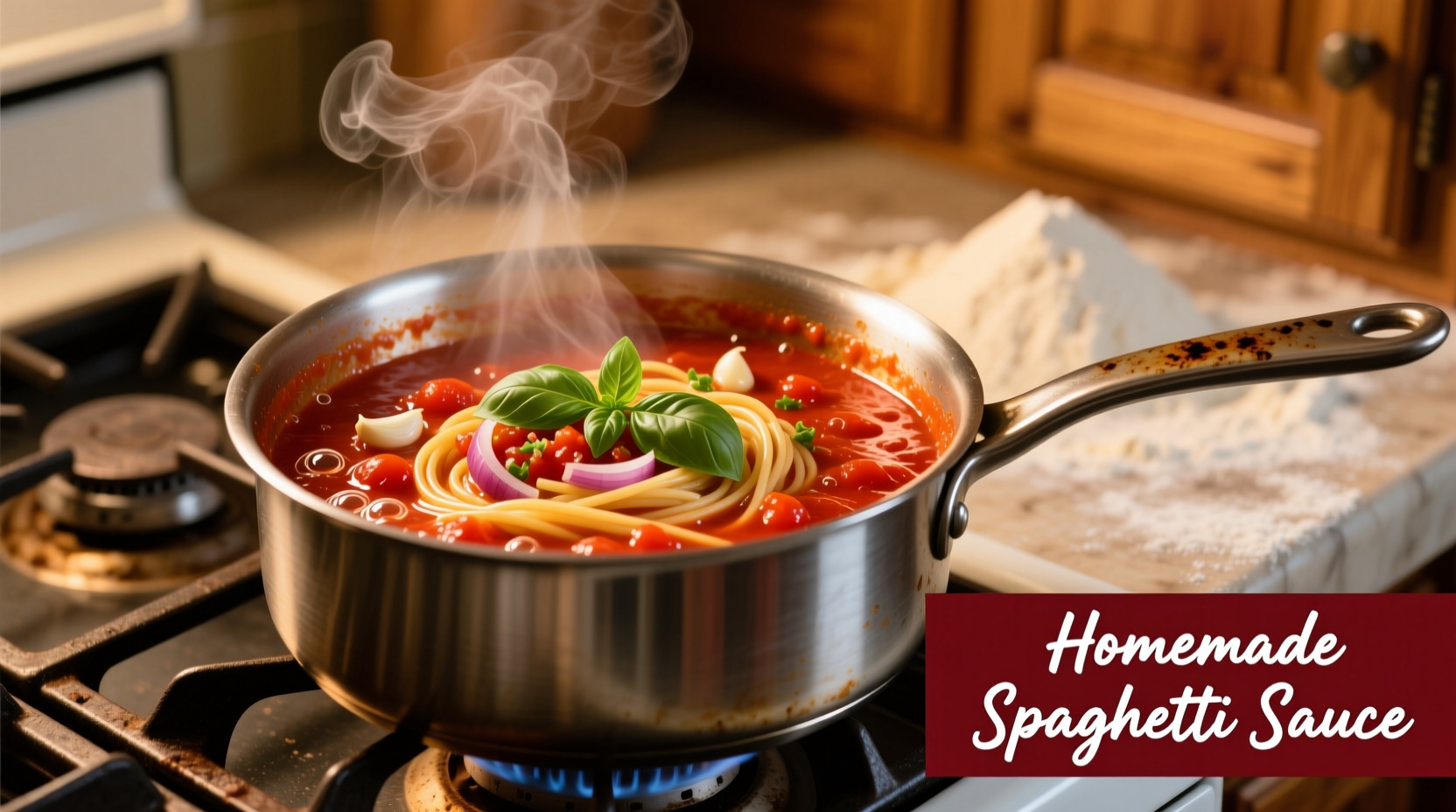Here's the perfect spaghetti tomato sauce recipe: Simmer 2 lbs crushed tomatoes with 3 minced garlic cloves, 1 small diced onion, 2 tbsp olive oil, 1 tsp dried oregano, 1 tsp dried basil, and a pinch of red pepper flakes for 45 minutes. Season with salt to taste. This authentic Italian-style sauce delivers rich flavor with minimal effort.
Why This Spaghetti Tomato Sauce Recipe Stands Out
Most store-bought sauces lack the vibrant, fresh flavor of homemade. This spaghetti tomato sauce recipe delivers restaurant-quality results with pantry staples. You'll create a versatile sauce that elevates simple spaghetti into a memorable meal in under an hour. Whether you're cooking for family weeknights or special occasions, this recipe adapts perfectly to your needs.
Your Complete Ingredient Guide
Gathering quality ingredients makes all the difference in your spaghetti tomato sauce. Here's what you'll need for authentic flavor:
- 2 pounds (900g) high-quality crushed tomatoes (preferably San Marzano)
- 3 tablespoons extra-virgin olive oil
- 1 small yellow onion, finely diced
- 3 garlic cloves, minced
- 1 teaspoon dried oregano
- 1 teaspoon dried basil
- 1/4 teaspoon red pepper flakes (optional)
- Salt to taste
- 1 teaspoon sugar (optional, balances acidity)
- Fresh basil leaves for garnish
| Ingredient | Why It Matters | Quality Tip |
|---|---|---|
| San Marzano tomatoes | Naturally sweeter with lower acidity | Look for DOP certification on the can |
| Extra-virgin olive oil | Creates flavor foundation | Use a fruity, medium-intensity oil |
| Fresh garlic | Provides aromatic depth | Minced finely for even distribution |
Step-by-Step Sauce Preparation
Follow these professional techniques for perfect spaghetti tomato sauce every time:
Building the Flavor Foundation
Heat olive oil in a heavy-bottomed pot over medium heat. Add diced onion and cook until translucent (about 5 minutes). Add minced garlic and red pepper flakes, stirring constantly for 1 minute until fragrant but not browned. This gentle cooking releases flavors without bitterness.
Simmering for Depth
Pour in crushed tomatoes, oregano, and basil. Bring to a gentle simmer, then reduce heat to low. Partially cover and cook for 45 minutes, stirring occasionally. The sauce should thicken gradually while developing complex flavors. According to the USDA Food Safety and Inspection Service, maintaining a gentle simmer ensures proper food safety while developing flavor.
Final Seasoning
Remove from heat and season with salt to taste. If tomatoes taste too acidic, add 1 teaspoon sugar. Stir in fresh basil just before serving. This final touch preserves the herb's bright flavor.

Common Sauce Problems and Solutions
Even experienced cooks encounter issues with tomato sauce. Here's how to fix them:
Sauce Too Thin?
Continue simmering uncovered for 10-15 minutes to reduce excess liquid. Alternatively, mix 1 tablespoon cornstarch with 2 tablespoons cold water and stir into simmering sauce.
Sauce Too Acidic?
Add small amounts of sugar (1/4 teaspoon at a time) or a pinch of baking soda to neutralize acidity. The USDA FoodData Central confirms that tomatoes naturally contain citric and malic acids, which some palates find too sharp.
Lacking Depth?
Stir in 1 tablespoon tomato paste during the last 15 minutes of cooking. Professional chefs often add a Parmesan rind while simmering for umami richness.
Serving and Storage Tips
For perfect results every time:
- Toss sauce with al dente spaghetti in the pot to help pasta absorb flavors
- Reserve 1/2 cup pasta water to adjust sauce consistency
- Finish with freshly grated Parmesan and basil leaves
- Store cooled sauce in airtight containers for up to 5 days
- Freeze portions for up to 3 months
Historical Context of Tomato Sauce
Tomato sauce as we know it emerged in 19th century Italy, despite tomatoes arriving from the Americas in the 16th century. According to culinary historian John Mariani in The Dictionary of Italian Food and Drink, Italians initially viewed tomatoes with suspicion, considering them ornamental rather than edible. It wasn't until the late 1700s that tomato-based sauces began appearing in regional Italian cookbooks, with Neapolitan cooks pioneering the simple combinations of tomatoes, garlic, and olive oil that form the basis of many spaghetti tomato sauce recipes today.
Frequently Asked Questions
Can I use fresh tomatoes instead of canned?
Yes, but you'll need about 3 pounds of ripe Roma tomatoes. Blanch, peel, and seed them first. Fresh tomatoes require longer cooking (60-75 minutes) to develop flavor and proper consistency compared to canned.
How do I make this sauce vegetarian-friendly?
This basic spaghetti tomato sauce recipe is naturally vegetarian. For extra richness without meat, add sautéed mushrooms, caramelized onions, or a Parmesan rind while simmering (remove before serving).
What's the best way to freeze tomato sauce?
Cool sauce completely, then portion into freezer bags or airtight containers, leaving 1-inch headspace for expansion. Lay flat for efficient storage. Properly frozen, sauce maintains quality for 3 months. Thaw overnight in the refrigerator before reheating.
Why does my sauce sometimes separate?
Separation occurs when oil and liquid components don't emulsify properly. To prevent this, maintain a gentle simmer (not a rolling boil) and stir occasionally. Adding a small amount of pasta water when combining with spaghetti helps create a cohesive sauce.
Can I make this sauce in a slow cooker?
Absolutely. Sauté onions and garlic first, then transfer to slow cooker with remaining ingredients. Cook on low for 4-6 hours. The slow, gentle heat develops deep flavors while requiring minimal attention.











 浙公网安备
33010002000092号
浙公网安备
33010002000092号 浙B2-20120091-4
浙B2-20120091-4